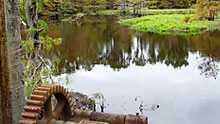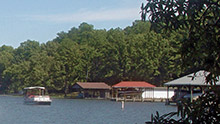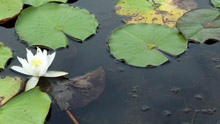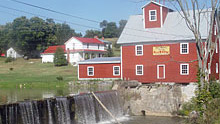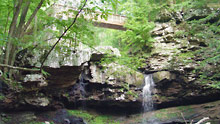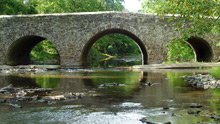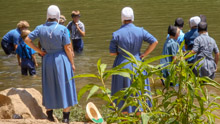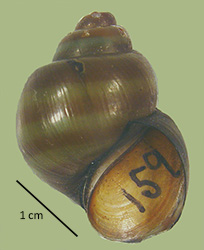> Habitat & Distribution
Pilsbry (1916) described the Viviparus population that would subsequently be identified as V. limi from "Dougherty, Georgia. Also Chetachee Creek, Ala." Katoh and Foltz (1994) matched a Viviparus population they sampled from Florida's Lake Talquin of the Ochlockonee River system to Pilsbry's nomen, adding that the shell morphology of most museum specimens from Dougherty, Terrell, and Calhoun counties, southwestern Georgia matched V. limi as well. FWGNA incidence unranked.
> Ecology & Life History
Cook (1949) has documented filter feeding (or perhaps ciliary feeding is more descriptive) in the European V. viviparus. But standard grazing also seems to be an option. The experiments of Duch (1976) convincingly demonstrated both a preference for silt-mud substrate over rock bottom in V. georgianus, and a strong orientation toward silt containing diatoms. The Lake Marion snails were commonly observed associated with macrophytes early in the brief history of their invasion, but recently are more commonly collected burrowing in sand. The experiments of Studier & Pace (1978) suggest that substrate preference in Viviparus may be more a function of the food it contains than its texture.
Northern V. georgianus populations show a broad range of life cycle pattern, maturing in a single year and reproducing iteroparously (Browne 1978), maturing in two years and reproducing iteroparously (Buckley 1986), and maturing in three years followed by semelparous reproduction (Jokinen et al. 1982). Applying the classification system of Dillon (2000: 156 162) these would be life cycle patterns G, Hi, and T, respectively. Browne reported a 9-month gestation period (June March) in his New York populations. The mortality that may follow reproduction (perhaps natural in some populations) can yield spectacular accumulations of dead shell. The energetic data collected by Browne (1978) suggested to Dillon (2000: 126 131) that V. georgianus is Undifferentiated with regard to its life history adaptation. Jokinen s (1987) analysis of the distribution of V. georgianus in Connecticut and New York led her to classify it as an A-B tramp, typically present only in the more species-rich communities.
David and colleagues (2017) estimated a mean summer prevalence of echinostomatid trematodes in one New York population of V. georgianus at a whopping 66.7%. Minnesota populations have been implicated as the primary intermediate host for digenean trematodes causing significant waterfowl mortalities. See my essay of 14Nov07 from the link below.
> Taxonomy & Systematics
The taxonomic history of the nomen Viviparus limi is complicated. In 1916 Henry Pilsbry published a four-line description of Viviparus contectoides compactus n. subsp. without figure. He described the shell as "compactly coiled, imperforate; whorls a little less inflated than contectoides." In 1918 he noted that the nomen compactus was preoccupied, amending the name to Viviparus contectoides limi. Clench (1962) synonymized contectoides under georgianus (Lea 1834), subsuming limi as a simple synonym under georgianus without comment. The taxon was not listed at any level by Burch (1989).
Viviparus limi was one of the two cryptic species, along with V. goodrichi, resurrected to the full species level by the study of Katoh and Foltz (1994). The authors reported the results of an electrophoretic survey of genetic variation at 27 allozyme-encoding loci showing V. goodrichi and V. limi both strikingly distinct from each other and from the much more common and widespread V. georgianus. Canonical discriminant analysis of variation in nine shell morphological measurements also separated all three species with little overlap. Consistent with Pilsbry's original description, limi was distinguished by a shell more slender than either goodrichi or georgianus: relatively narrow, especially in aperture width.
The higher-level taxonomy of the North American Viviparidae has been relatively stable since the brief monographs of Clench (1962) and Clench & Fuller (1965). The single-character classification published by Stelbrink et al. (2020) is interesting, but (long experience suggests) too volatile to trigger any taxonomic reshuffling at this time. See my essay of 9Mar21 from the link below formore.
> Maps and Supplementary Resources
> Essays
- I posted an essay on invasive viviparids in South Carolina to the FWGNA web site on 29Oct2003. There are links to several additional photos. See Invasive Viviparids in South Carolina
- In 2007 Viviparus georgianus was implicated as the primary intermediate host for digenean trematodes causing massive waterfowl mortalities in Minnesota. See Ducks, Snails, and Worms - When Invasive Species Conspire!
- My FWGNA blog post of 12Sept11, Dispatches from the Viviparid Front, included an item on a citizen's effort to monitor invasive viviparids (of all species) in Wisconsin, with links to some good references.
- I reviewed all the Viviparus records in the USGS Nonindigenous Aquatic Species database while researching my post of 16Oct15, "To Only Know Invasives." I didn't find any well-documented populations here in The East previously unknown to me.
- I reviewed A Gene Tree for the Worldwide Viviparidae published by Stelbrink et al. (2020) in my post of 9Mar21. The focus of that essay was on Cipangopaludina, but the origin of northern V. georgianus populations was also addressed.
> References
Aldridge, D.W., Russell-Hunter, W. D., & Buckley, D.E. (1986) Age-related differential catabolism in the snail, Viviparus georgianus, and its significance in the bioenergetics of sexual dimorphism. Can. J. Zool. 64: 340-346.
Archer, A. F. (1933) A new variety of Viviparus contectoides (W. G. Binney) from Jackson Co., Florida. The Nautilus 47: 18 20.
Browne, R. A. (1978) Growth, mortality, fecundity, biomass and productivity of four lake populations of the prosobranch snail, Viviparus georgianus. Ecology 59: 742-750.
Buckley, D.E. (1986) Bioenergetics of age-related versus size-related reproductive tactics in female Viviparus georgianus . Biol. J. Linn. Soc. 27: 293-309.
Burch, J.B. (1989) North American Freshwater Snails. Malacological Publications, Hamburg, Michigan. 365 pp.
Clarke, A. (1981) The Freshwater Molluscs of Canada. National Museums of Canada. 445 pp.
Clench, W. (1962) A catalogue of the Viviparidae of North America with notes on the distribution of Viviparus georgianus, Lea. Occas. Pprs. on Mollusks, Mus. Comp. Zool. Harvard, 2, 261-87.
Clench, W. & Fuller, S. (1965) The genus Viviparus in North America. Occas. Pprs. on Mollusks, Mus. Comp. Zool. Harvard, 2, 385-412.
Cook, P. (1949) A ciliary feeding mechanism in Viviparus viviparus (L). Proc. Malacol. Soc. Lond. 27: 265-271.
David, A.A., H. Zhou, A. Lewis, A. Yhann, and S. Verra (2017) DNA barcoding of the banded mystery snail, Viviparus georgianus in the Adirondacks with quantification of parasitic infection in the species. Amer. Malac. Bull. 35: 175 - 180.
Dillon, R. T. (2000) The Ecology of Freshwater Molluscs. Cambridge University Press. 509 pp.
Duch, T. (1976) Aspects of the feeding habits of Viviparus georgianus. Nautilus 90: 7-10.
Jokinen, E. (1987) Structure of freshwater snail communities: Species-area relationships and incidence categories. Amer. Malac. Bull. 5: 9 - 19.
Jokinen, E.H., Guerette, J, & Kortmann, RW (1982) The natural history of an ovoviviparous snail, Viviparus georgianus (Lea), in a soft-water eutrophic lake. Freshwat. Invertebr. Biol. 1: 2-17.
Katoh, M. & Foltz, D. W. (1994) Genetic subdivision and morphological variation in a freshwater snail species complex formerly referred to as Viviparus georgianus (Lea). Biol. J. Linn. Soc. 53: 73-90.
Pilsbry, H. (1916) New subspecies of Viviparus and Campeloma. The Nautilus 30: 41 43.
Pilsbry, H. (1918) Viviparus contectoides limi, new name for V. c. compactus. The Nautilus 32:71.
Stelbrink, B. and 15 others (2020) Global diversification dynamics since the Jurassic: Low dispersal and habitat-dependent evoution explain hotspots of diversity and shell disparity in river snails (Viviparidae) Systematic Biology 69: 944 - 961.
Studier, E & Pace, G. (1978) Oxygen consumption in the prosobranch snail Viviparus contectoides. IV. Effects of dissolved oxygen level, starvation, density, symbiotic algae, substrate composition and osmotic pressure. Comp. Bioch. Physiol. A 59: 199 - 204.
Vail, V.A. (1977) Comparative reproductive anatomy of 3 viviparid gastropods. Malacologia, 16: 519-520.
Vail, V.A. (1978) Seasonal reproductive patterns in 3 viviparid gastropods. Malacologia, 17: 73-97.

